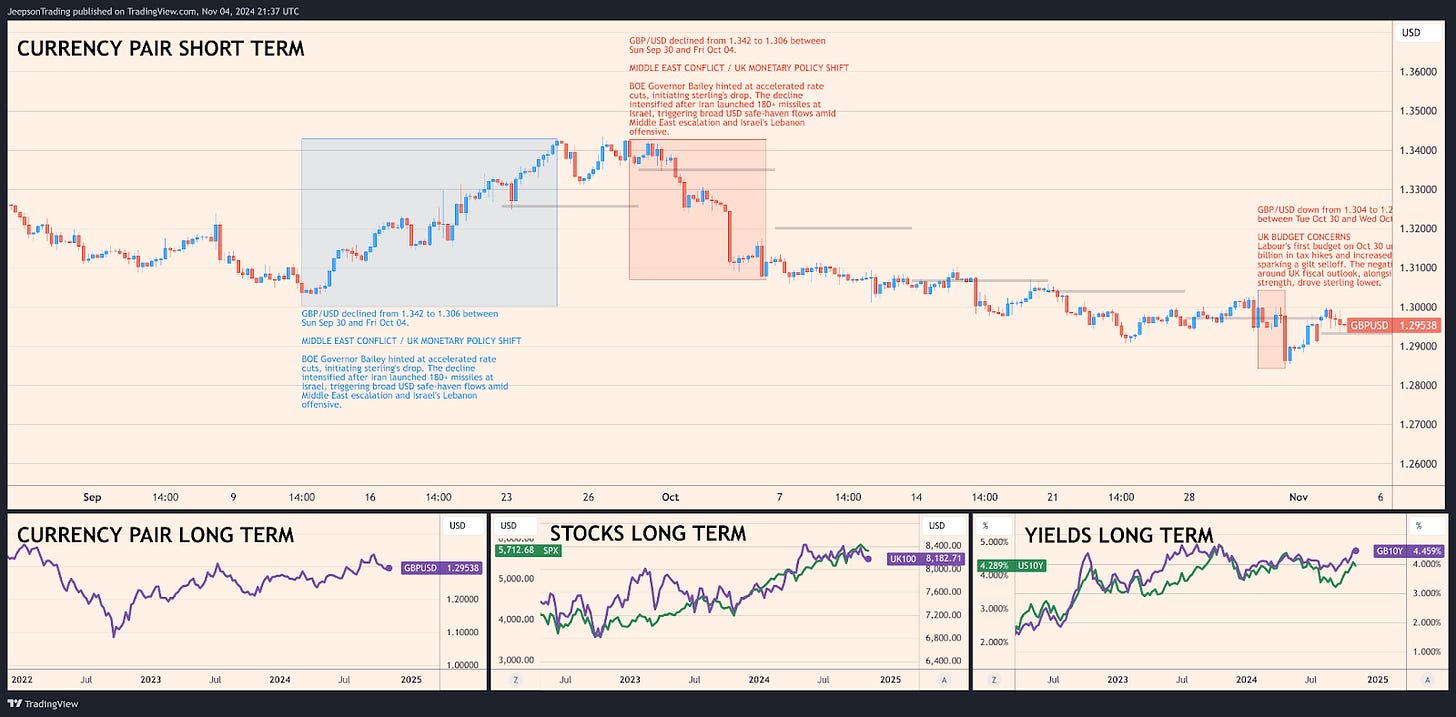Market Analysis
Monday, November 04, 2024 (Week 45)
Currency markets face heightened volatility ahead of tomorrow's US presidential election, where polls show a tightening race between Vice President Kamala Harris and former President Donald Trump. The Australian dollar commands particular attention with the Reserve Bank of Australia's rate decision also due Tuesday. These pivotal events, combined with ongoing as traders navigate the aftermath of recent central bank decisions. The Reserve Bank of New Zealand's aggressive 50-basis point cut to 4.75% on October 24th contrasts sharply with the ECB's more measured 25-basis point reduction to 3.25%. Meanwhile, sterling traders grapple with the implications of Labour's first UK budget, which unveiled £40 billion in tax increases alongside expanded borrowing plans. These policy divergences, combined with persistent Middle East tensions, create distinct opportunities across major currency pairs.
Sterling Under Budget Pressure: GBP/USD at Policy Crossroads
The pound's trajectory reflects the complex interplay between fiscal expansion and monetary policy uncertainty. Last week's 1.5% decline against the dollar, culminating in sterling touching 1.284 on October 31st, demonstrates the immediate market reaction to Labour's ambitious fiscal plans. Bank of England Governor Andrew Bailey's upcoming monetary policy decision this Thursday takes on heightened significance against this backdrop.
GBP/USD trading centres around the London-New York session overlap, with primary liquidity provided by global investment banks and hedge funds. The pair traditionally shows strong correlation with UK gilt yields, which have risen sharply following the budget announcement, with the 10-year reaching 4.51% on October 30th.
Recent Developments:
Wednesday, October 30: Labour unveiled £40 billion tax increase budget
Thursday, October 31: GBP/USD falls to 1.284, a three-week low
Key Upcoming Events:
Thursday, November 7: Bank of England rate decision and Monetary Policy Report
Sterling's decline accelerated through October, falling from 1.342 to 1.306 between September 30 and October 4, initially driven by the Iran-Israel conflict's impact on risk sentiment. The recent drop from 1.304 to 1.284 between October 30-31 directly correlates with market concerns over Labour's fiscal plans, particularly the expanded borrowing outlook.
Bullish Case
Sterling could find support if Thursday's Bank of England meeting maintains a hawkish stance on inflation while providing clear guidance on managing fiscal-monetary policy coordination. A stabilisation in gilt yields following the initial budget reaction would further support pound strength.
Bearish Risks
Further sterling weakness could emerge if gilt yields continue rising in response to expanded borrowing plans. This scenario becomes more likely if the Bank of England adopts a dovish tone Thursday, potentially signalling concern about the growth impact of fiscal tightening.
AUD/JPY: RBA Decision and US Election Test Risk Sentiment
In a few hours will be the RBA's rate decision (see trade plan here for paid subscribers). The Reserve Bank of Australia's meeting gains particular significance as markets assess whether it will maintain rates at 4.35% amid mixed economic signals. September inflation data showed signs of moderation, with the monthly CPI indicator falling to 2.7% from 3.5%, entering the RBA's 2-3% target range for the first time in three years. Meanwhile, employment remains robust, with the economy adding 64,100 jobs in September, significantly exceeding forecasts of 25,000.
The US election adds another layer of complexity. Credit Agricole's analysis identifies two primary scenarios affecting currency markets: a potential Harris presidency with divided Congress that could yield policy gridlock, or a "red wave" delivering both presidency and Congress to Republicans, potentially unleashing substantial fiscal stimulus alongside aggressive trade measures. Deutsche Bank suggests limited downside in a divided government scenario but significant upside potential under a Republican sweep.
The Australian dollar versus Japanese yen cross rate captures both monetary policy divergence and shifting risk appetite. The Bank of Japan's decision to maintain rates at 0.25% during its October meeting, citing political uncertainty ahead of the US election, contrasts with the Reserve Bank of Australia's more hawkish stance on inflation risks.
AUD/JPY serves as a key barometer of global risk sentiment, particularly sensitive to developments in China's economy given Australia's significant export exposure. The cross typically sees heightened activity during the Asian trading session.
Recent Developments:
Thursday, October 31: BOJ holds rates at 0.25%
Friday, November 1: Australian monthly CPI shows cooling to 2.7%
Monday, November 4: RBA rate decision preview shows analysts unanimously expect hold at 4.35%
Imminent Events:
Tuesday, November 5: RBA Interest Rate Decision
Tuesday, November 5: US Presidential Election results begin emerging
Tuesday, November 5: Any RBA forward guidance could significantly impact AUD crosses
Market Developments
AUDJ/PY trading patterns reflect both policy divergence and risk sentiment shifts. The pair has maintained a relatively stable range around 100.00 despite broader market volatility, supported by the BOJ's continued accommodative stance.
EUR/NZD: Monetary Policy Contrast Drives Direction
The euro-New Zealand dollar cross rate exemplifies stark monetary policy divergence. The RBNZ's aggressive 50-basis point cut to 4.75% on October 24th, marking its second consecutive reduction, stands in marked contrast to the ECB's more measured 25-basis point cut to 3.25%.
EUR/NZD trading volume peaks during the European session-Asia crossover, driven primarily by institutional investors positioning for central bank policy divergence.
Recent Developments:
Thursday, October 24: RBNZ cuts rates 50 bps to 4.75%
Thursday, October 24: ECB reduces rates 25 bps to 3.25%
Key Upcoming Events:
Tuesday, November 5: RBNZ Financial Stability Report
Wednesday, November 6: ECB President Lagarde Speech
EUR/NZD climbed from 1.783 to 1.827 between October 22-31, reflecting the growing policy divergence between the two central banks. The RBNZ's more aggressive easing stance, coupled with dovish forward guidance, continues to pressure the New Zealand dollar.
Sources
Bank of England, European Central Bank, Reserve Bank of New Zealand, Bank of Japan, Reserve Bank of Australia, Office for Budget Responsibility, UK.





